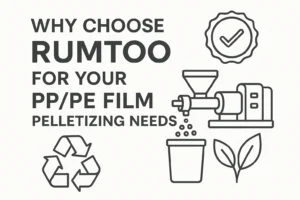As the world tackles the growing crisis of plastic waste, innovative recycling technologies are crucial for achieving both environmental goals and business success. The Plastic Film Squeezer represents a major step forward—enabling more efficient, cost-effective, and sustainable recycling of plastic films, and playing a vital role in the circular economy.
Why Are Plastic Films So Challenging to Recycle?
Plastic films, widely used in packaging, are lightweight and highly moisture-retentive. These properties make them difficult to process using traditional recycling methods, often resulting in low throughput and high energy costs for drying.
What Makes the Plastic Film Squeezer Unique?
The Plastic Film Squeezer leverages a robust screw press design to efficiently squeeze out moisture from washed plastic films such as LDPE, LLDPE, and PP woven bags. After dewatering, films are further densified and partially heated, preparing them for direct pelletizing or compounding.
Key Features & Advantages:
- High Moisture Reduction: Reduces water content to below 5%, far outperforming air or sun drying.
- Energy Efficient: Uses significantly less energy than traditional thermal dryers, lowering your operating costs and carbon footprint.
- Improved Pellet Quality: Produces clean, drier film flakes that result in higher-quality pellets and more stable extrusion.
- Increased Throughput: Speeds up recycling plant operations, enabling you to process larger volumes with the same resources.
- Easy Integration: Compact design fits seamlessly into new or existing washing and pelletizing lines.
Environmental & Economic Benefits
Adopting a Plastic Film Squeezer delivers immediate and long-term benefits for recyclers and the planet:
- Reduced Landfill Waste: Enables higher recycling rates for plastic film, diverting large volumes from landfill and the environment.
- Lower Energy Bills: Less energy required for drying means reduced operational costs and lower greenhouse gas emissions.
- Boosted Profitability: With higher capacity and better product quality, recycling businesses can grow faster and maximize ROI.
Supporting the Circular Economy
By turning hard-to-recycle plastic films into valuable resources, the Plastic Film Squeezer embodies the core principles of the circular economy. It helps close the loop by making it practical and profitable to reintroduce used films back into manufacturing, minimizing the need for virgin plastic.
Why Choose Rumtoo for Your Plastic Film Recycling Solution?
- Proven Technology: Thousands of successful installations worldwide, backed by industry-leading expertise.
- Customized Solutions: Tailored machine options to match your specific film types, capacities, and production needs.
- Full Service Support: From process consulting and line design to installation, training, and after-sales service—Rumtoo is your trusted partner in plastic film recycling.
- Transparent Pricing: All quotes provided with clear specs and no hidden fees. Export support available (FOB Shanghai, CIF, etc.).
FAQs
How does the Plastic Film Squeezer help the circular economy?
By drying and densifying plastic films, it makes them suitable for high-quality recycling, reducing waste and supporting the reuse of materials.
What plastics can it handle?
Ideal for LDPE, LLDPE, stretch film, agricultural film, and PP woven bags.
Is it energy efficient?
Yes, its mechanical design cuts drying energy use by up to 70% compared to hot air systems.
Can it increase my plant’s capacity?
Absolutely—it enables faster processing, higher throughput, and more profitable operations.
Ready to Upgrade Your Film Recycling Process?
Contact Rumtoo’s expert team today for a customized Plastic Film Squeezer solution, technical consultation, and competitive pricing. Let’s build a greener, more profitable future—one plastic film at a time.
Internal links for further reading:

